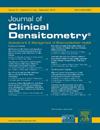Evaluating lower limits of body fat percentage in athletes using DXA
IF 1.6
4区 医学
Q4 ENDOCRINOLOGY & METABOLISM
引用次数: 0
Abstract
Body fat percentage (BF%) is routinely measured in athletes to monitor training and dietary interventions. Dual energy x-ray absorptiometry (DXA) is widely considered the gold standard body composition measurement technique, but DXA BF% values measure consistently higher than other techniques. Therefore, the main purpose of this study is to determine the lowest DXA-estimated whole-body fat mass in free-living athletes with unrestricted access to food. In this cross-sectional analyses, 732 participants across 18 competitive sports (643 athletes; 88 %) plus two (male and female) “non-athlete” male and female cohorts (89 non-athletes; 12 %) underwent a whole-body DXA scan using a Horizon A Hologic™ device (software version 13.6.0.5; TBAR 1209), performed and analyzed by a single operator. The average BF % in 454 males (20.9 ± 3.8 years) was 18.2 ± 4.9 % (range 10.3 - 37.2 %), with basketball players having the lowest BF% (15.3 ± 2.6 %) and non-athletes having the highest BF% (21.6 ± 5.4 %) (1-way ANOVA between 10 teams: F = 12.3; p < 0.0001). The average BF% in 278 females (21.3 ± 5.5 years) was 27.1 ± 5.1 % (range 16.2 - 45.3 %), with runners having the lowest BF% (23.5 ± 3.5 %) and non-athletes having the highest BF% (31.7 ± 6.3 %) (1-way ANOVA between 10 teams F = 12.9; p < 0.0001). In absolute values (kg), the average body fat for males was 19.9 ± 8.0 kg (range 6.7 - 62.0 kg) and 18.9 ± 6.4 kg (range 9.2 - 49.7 kg) for females. These data suggest that the lower limits of whole-body fat mass in free-living competitive athletes is approximately 10 % for males and 16 % for females. Whether these DXA-derived fat thresholds represent “healthy” levels, or how much of these DXA-derived fat depots represent essential fat stores located within lean soft tissue mass, remains unclear.
使用DXA评估运动员体脂率下限。
体脂率(BF%)是监测运动员训练和饮食干预的常规测量方法。双能x射线吸收测定法(DXA)被广泛认为是身体成分测量技术的金标准,但DXA BF%的测量值始终高于其他技术。因此,本研究的主要目的是确定在不受食物限制的自由生活运动员中,dxa估计的最低全身脂肪量。在这个横断面分析中,732名参与者来自18个竞技项目(643名运动员;88 %)加上两个(男性和女性)“非运动员”男女组别(89名非运动员;12 %)使用Horizon a Hologic™设备(软件版本13.6.0.5;TBAR 1209),由单个操作员执行和分析。BF % 454年男性平均(20.9 ± 3.8年)是18.2 ±4.9 %(范围10.3 - 37.2 %),篮球运动员有最低的BF %(15.3 ±2.6 %)和普通人有最高的BF %(21.6 ±5.4 %)(1路的10个团队之间的方差分析:F = 12.3;p
本文章由计算机程序翻译,如有差异,请以英文原文为准。
求助全文
约1分钟内获得全文
求助全文
来源期刊

Journal of Clinical Densitometry
医学-内分泌学与代谢
CiteScore
4.90
自引率
8.00%
发文量
92
审稿时长
90 days
期刊介绍:
The Journal is committed to serving ISCD''s mission - the education of heterogenous physician specialties and technologists who are involved in the clinical assessment of skeletal health. The focus of JCD is bone mass measurement, including epidemiology of bone mass, how drugs and diseases alter bone mass, new techniques and quality assurance in bone mass imaging technologies, and bone mass health/economics.
Combining high quality research and review articles with sound, practice-oriented advice, JCD meets the diverse diagnostic and management needs of radiologists, endocrinologists, nephrologists, rheumatologists, gynecologists, family physicians, internists, and technologists whose patients require diagnostic clinical densitometry for therapeutic management.
 求助内容:
求助内容: 应助结果提醒方式:
应助结果提醒方式:


